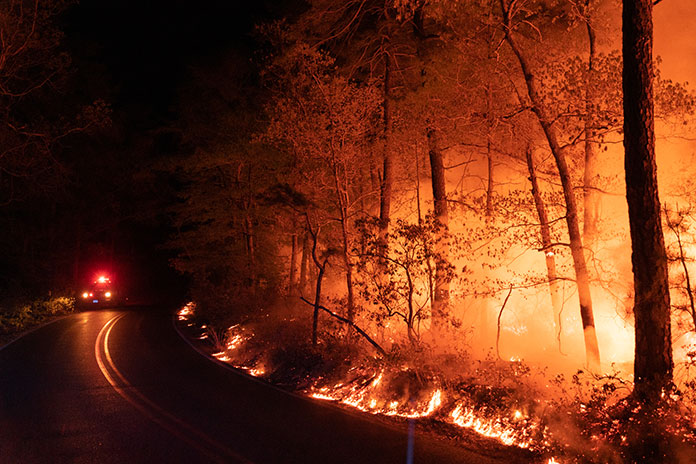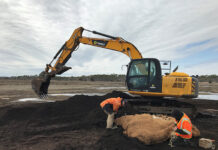
JERSEY SHORE – Within the first half of 2021, two major forest fires have affected the lush greenery that runs throughout our region.
Monmouth and Ocean counties are not only home to beautiful beaches, but also dense woods like the Pine Barrens spreading across southern Ocean.
In March of this year, a forest fire broke on the Brick/Lakewood border. The fire destroyed 167 acres of land, shutting down the Garden State Parkway and making several stores close down. Strong winds of around 40 miles per hour and low humidity around 20 percent made it difficult for firefighters to battle the blaze. As a result, two commercial buildings were destroyed along with 29 residential properties being damaged.
Officials were able to determine that the fire was intentionally set, although they still have not identified any suspects.
“Detectives have attempted to interview approximately 60 potential witnesses and reviewed video recordings from cameras in proximity to the fire. The vast majority of these potential witnesses have been less than cooperative with our investigation, and as such, we are currently at an impasse at this point in time,” Ocean County Prosecutor Bradley D. Billhimer said.

Two months later, an even bigger forest fire burned across southern New Jersey, starting near the Bass River State Forest in Burlington County, spreading into Little Egg Harbor Township and consuming 641 acers of forest.
So how do these fires grow in size so quickly? Officials call it “forest fire season” when the land is dry in the spring and fall months with little greenery, with the warm sun and a breeze. These factors increase the risk of a forest fire occurring. Trevor Raynor, a Forest Fire Warden for NJ Forest Fire Service who covers the Southern Ocean area, explained how they take several steps to prevent fires, prescribed burning being the main method.
“We’re very aggressive to prescribed burning in New Jersey and for such a densely populated state we accomplish a lot of acreage. Prescribed burning is setting controlled fires in the dormant season like the fall and winter. With that fire we burn all the leaves and debris out of the woods and if there to be a fire in the future there’s less to burn,” Raynor said.
The NJ Forest Fire Service uses multiple types of equipment to either prevent and/or corral a fire. Raynor, who was a part of the recent Ballanger fire in Southern Ocean, said they heavily rely on their fire towers in order to catch any forest fires early.
“The fire towers play a critical role. My fire was detected by a fire tower. Had it not been, the next person to call 911 on that fire would have been at the back of people’s houses. But the fire tower was able to find out the fire was deep in the woods,” Raynor said. “If we relied on the 911 system and didn’t have fire towers, the first alert for that wild fire would have been too late, it would already be impacting homes.”
Should we be concerned about these vast forest fires occurring and the potential it has to not only wipe out huge swaths of Ocean and Monmouth Counties? Although townships like Howell have had some small fires, it hasn’t faced any to the extent as Lakewood or Southern Ocean, but the possibility is always there.
“It can happen right here in Howell. We have large tracks of brush and trees that it could run through pretty quickly with the right wind and right conditions. It could involve some houses because of the lack of defensible space,” Robert H. Lewis, Chief of the Howell Township Fire Bureau, said. “It is a very good possibility. New Jersey actually is almost a better place, if you could say, for wild fires than what you read about in California. It’s just that California has more open area and they get bigger fires. We have so much development that has ended up in the woods, and people don’t realize that they need to take actions for themselves to prevent disasters from occurring. The biggest thing with fires is once it gets going and is hot enough, it will burn at the top of the trees in the dry seasons and there’s no way to stop that, they just move so fast.”
“Wildfires are always a threat in New Jersey,” Raynor said. “It’s not a matter of ‘if’ it’s a matter of when the wild fire occurs. Wherever the ignition source is, that’s where that fire is. It could be out in the middle of nowhere or it could be right next to a house.”

NJ Forest Fire Service and many other local fire stations do everything they can to prevent forest fires, but what can the community do to avoid fires from spreading? Residents who live in wooded areas should create defensible space around their home that acts as a barrier between their land and any potential forest fire.
“If you have a piece of property and you want to be in the middle of the woods with all your trees around that’s fine, but you need to create some kind of natural barrier so we can assist in protecting your home,” Lewis said. “If you have brush and trees that come up to the woods right up within 10 or 20 feet of your house, that doesn’t give us any way to be able to protect your house. We like to start with 100 feet. Give us 100 feet of break, minimize the amount of things that can burn in between your house and that gives us a chance to get in there to defend your house.
“The biggest thing people need to realize is that they need to help us protect them and if they are backing up to woods, they need to take action. Another big thing is people use fire pits and forget to constantly attend them. You need to put out your fire pits before you go to bed. That’s one of the biggest complaints we get from people,” Lewis said.
“We always like to advocate defensible space. If people have 100 feet of space, that makes our job easier in protecting them,” Raynor said. “Help us help you. Be fire-wise. Have defensible space and an evacuation plan. It’s like a hurricane, but with a wild fire it starts and within an hour it could be impacting you. Whereas a hurricane you prepare a couple days ahead. It’s always important to have that plan in place.”






